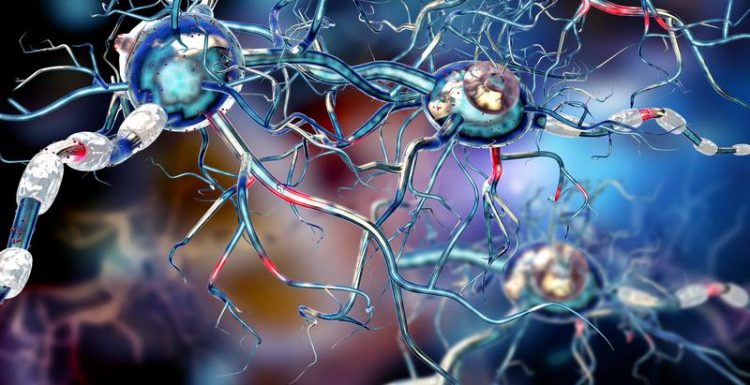B Cells Among Factors Leading to Brain Lesions in Multiple Sclerosis

In multiple sclerosis, the immune system attacks the myelin sheaths of the nerve fibres (white). Ralwel/iStockphoto
Multiple sclerosis (MS) is a chronic autoimmune disease of the central nervous system. The body’s own immune cells attack and damage the layer that surrounds nerve cells in the brain and spinal cord, which affects their ability to communicate with each other.
The disease, which affects around 2.5 million people worldwide, is a common cause of disability in young adults and affects women particularly often. MS can lead to severe neurological disabilities such as sensory problems, pain and signs of paralysis.
B cells activate T cells
A team led by neurologist Roland Martin and immunologist Mireia Sospedra at the University of Zurich (UZH), the University Hospital Zurich (USZ) and researchers at the Karolinska Institute in Sweden has now discovered a key aspect in the pathogenesis of MS.
“We were able to show for the first time that certain B cells – the cells of the immune system that produce antibodies – activate the specific T cells that cause inflammation in the brain and nerve cell lesions,” says Roland Martin, Director of the Clinical Research Priority Program Multiple Sclerosis at UZH.
Novel MS drugs attack B cells
Until recently, MS research had mainly focused on T cells, or T helper cells. They are the immune system’s “guardians”, which for example sound the alarm if the organism is infected with a virus or bacteria. In about one in a 1,000 people, the cells’ ability to distinguish between the body’s own and foreign structures becomes disturbed.
The effect of this is that the misguided T cells start to attack the body’s own nerve tissue – the onset of MS. However, the T cells aren’t the sole cause of this. “A class of MS drugs called Rituximab and Ocrelizumab led us to believe that B cells also played an important part in the pathogenesis of the disease,” explains Roland Martin. These drugs eliminate B cells, which very effectively inhibits inflammation of the brain and flare-ups in patients.
B cells’ “complicity” revealed
The researchers established the role of B cells by using an experimental in-vitro system that allowed blood samples to be analyzed. The blood of people with MS revealed increased levels of activation and cellular division among those T cells attacking the body’s myelin sheaths that surround nerve cells. This was caused by B cells interacting with the T cells. When the B cells were eliminated, the researchers found that it very effectively inhibited the proliferation of T cells. “This means that we can now explain the previously unclear mechanism of these MS drugs,” says Roland Martin.
Activated T cells migrate to the brain
Moreover, the team also discovered that the activated T cells in the blood notably included those that also occur in the brain in MS patients during flare-ups of the disease. It is suspected that they cause the inflammation. Further studies showed that these T cells recognize the structures of a protein that is produced by the B cells as well as nerve cells in the brain. After being activated in the peripheral blood, the T cells migrate to the brain, where they destroy nerve tissue. “Our findings not only explain how new MS drugs take effect, but also pave the way for novel approaches in basic research and therapy for MS,” concludes Roland Martin.
Funding
The research project was mainly funded through an “ERC Advanced Grant” from the European Research Council. Further funds came from UZH’s Clinical Research Priority Program Multiple Sclerosis, the Swiss Multiple Sclerosis Society, the Swiss National Science Foundation and a number of Swedish funding instruments.
Prof. Dr. med. Roland Martin
Department of Neurology
UniversityHospital Zurich
Phone: +41 44 255 11 25
E-mail: roland.martin@usz.ch
Ivan Jelcic, Faiez Al Nimer, Jian Wang, Verena Lentsch, Raquel Planas, Ilijas Jelcic, Aleksandar Madjovski, Sabrina Ruhrmann, Wolfgang Faigle, Katrin Frauenknecht, Clemencia Pinilla, Radleigh Santos, Christian Hammer, Yaneth Ortiz, Lennart Opitz, Hans Grönlund, Gerhard Rogler, Onur Boyman, Richard Reynolds, Andreas Lutterotti, Mohsen Khademi, Tomas Olsson, Fredrik Piehl, Mireia Sospedra, and Roland Martin. Memory B Cells Activate Brain-Homing, Autoreactive CD4+ T Cells in Multiple Sclerosis. Cell. August 30, 2018. DOI: 10.1016/j.cell.2018.08.011
http://www.media.uzh.ch/en/Press-Releases/2018/Multiple-Sclerosis.html
Media Contact
All latest news from the category: Life Sciences and Chemistry
Articles and reports from the Life Sciences and chemistry area deal with applied and basic research into modern biology, chemistry and human medicine.
Valuable information can be found on a range of life sciences fields including bacteriology, biochemistry, bionics, bioinformatics, biophysics, biotechnology, genetics, geobotany, human biology, marine biology, microbiology, molecular biology, cellular biology, zoology, bioinorganic chemistry, microchemistry and environmental chemistry.
Newest articles

NASA: Mystery of life’s handedness deepens
The mystery of why life uses molecules with specific orientations has deepened with a NASA-funded discovery that RNA — a key molecule thought to have potentially held the instructions for…

What are the effects of historic lithium mining on water quality?
Study reveals low levels of common contaminants but high levels of other elements in waters associated with an abandoned lithium mine. Lithium ore and mining waste from a historic lithium…

Quantum-inspired design boosts efficiency of heat-to-electricity conversion
Rice engineers take unconventional route to improving thermophotovoltaic systems. Researchers at Rice University have found a new way to improve a key element of thermophotovoltaic (TPV) systems, which convert heat…



